Elizabeth Hammond's Ancestors |
Click on a name for info, click on an arrow to follow that branch, click Home to go to the main page, or click for an Alphabetic List of all Names. |
 |
| Two arrows are disabled at this time. |
| Note: Before 1752 the year began on March 25th. Dates between January 1st and March 24th were at the end of the year, not the beginning. |
William Hammond was baptized on and probably born just prior to October 30, 1575 in Lavenham, County Suffolk, England. He was the third child of seven, and the only surviving son of Thomas Hammond and Rose Trippe (his younger brother, Thomas, having died in infancy). He was left on his own at 14 years old, by his mother’s remarriage upon the death of his father in 1589. He married Elizabeth Paine in Lavenham on June 9, 1605 and their eight children were all born in Lavenham (see Elizabeth for details). According to Frederick Stam Hammond's History and Genealogies of the Hammond Families in America Volume 1, they may have lived in Essex: “There is some evidence to show that the family of William Hammond had lived in Dedham, Essex, England, for a period at least, before their emigration to America. The evidence in the suit of Edmund Shearman, of Dedham, Essex, against Thomas Hammond, . . . and the subsequent proceedings, and also the marriage of John Hammond to Abigail Salter, of Dedham . . . all show a connection with that town in England. It is possible that William removed there from Lavenham some years prior to the emigration to America.”
According to William Richard Cutter in his book Genealogical and Personal Memoirs Relating to the Families of Boston and Eastern Massachusetts, “William Hammond was admitted freeman in Watertown, May 25, 1636, and before 1644 possessed seven lots by grants and three by purchase.” His homestead of “40 acres situated on the west of Common Street.” It was bounded on the east and north by lands of his brother-in-law, Dr. Simon Eire, on the west by John Simson, Isaac Sterne and John Warren, and on the south by Thomas Boyden. Bond's History of Watertown says, "It is probable that William Hammond settled first on the Cambridge Road, very near the Cambridge line. Whether this was a grant to him the records do not show. He sold it early and settled on his 40-acre homestall, situated east of Pequusset meadow. He also owned three small lots in Pequusset meadow, one of these granted to him and the other two purchased. This homestall passed to his son (grandson) Thomas." On March 10, 1642, in the division of lands, he was granted lot No. 76, in the 4th Division, containing 165 acres, and this, with his other holdings, made him one of the largest land owners in the town. Cutter writes “His independence in religious matters in those days of puritanical restrictions of individual opinion brought Mr. Hammond somewhat into disfavor with the bigoted majority of his fellow townsmen, records showing that he was not often in public office, and his house was ordered to be searched, May 27, 1661, for hidden Quakers, it being known that he had considerable sympathy with that sect.” Others include details on the offenses and fines: “. . for an offense against the laws concerning baptism, . . .for neglect of publick worship. . . 14 Sabbaths at 5 shillings each . .” Warnings were given “. . . for not attending publick worship . . .” and the houses searched were of “. . . old Warren and Goodman Hammond.” Although he was unpopular with some of his neighbors, he had many friends, who shared his opinions. His near neighbor and most intimate friend was John Warren, who came from the same area in Suffolk, England. Their two families were close friends for several generations prior to coming to America. Considerable independence in religious matters, great love of liberty and sympathy for all who are persecuted for conscience sake seem to have been inherent family traits for generations past. It is probable that Hammond and his friend, Warren, were both inclined toward the religious teaching of Roger Williams, but were too conservative to subject themselves to the persecution that his more radical followers were compelled to endure. This view is supported by the fact that many of their descendants were rigid adherents of the Baptist Church. The tendency, however, in this family has been toward great liberty of thought in religious matters and many of the descendants have been connected with the Unitarian and Universalist denominations, while many in the later generations didn’t become members of any church. The will of William Hammond is on file at East Cambridge, Massachusetts, (Middlesex Probate No. 7167), dated July 1662, and proved on December 16, 1672. He "leaves to wife Elizabeth his whole estate during her life. . . To son, John, all lands, & after her death. . . To Thomas Hamond, sonne of my sonne, Thomas Hamond, deceased, œ40" at the age of 21 years. "If said Thomas, or any for him, oppose this will, . . .” then |
| ~< Back to Chart >~ |
Elizabeth’s husband William left for England some time between 1630 and 1634 with his oldest children, leaving her behind with the younger ones, to join him later. Elizabeth’s exodus from England was delayed a month because her fellow passengers and maybe herself, tried to avoid taking the Oaths of Supremacy and Allegiance. The ship could not leave Ipswich in Suffolk without every passenger taking the oath, but it did anyway. At the end of April of 1634, at 47 years old, Elizabeth with her younger children, Elizabeth, aged 15; Sarah, aged 10; and John, aged 7, left Ipswich, England, on the ship, Francis with John Cutting as Master to join her husband in New England. After their arrival in Massachusetts Bay, both John Cutting and William Andrews (Master of the ship Elizabeth) wrote back to England on November 12, 1634, saying that they “pray to be released from bonds of presentation of certificates, Elizabeth joined her husband and they settled in Watertown, Middlesex County, Massachusetts (mouse over image left) prior to May 25, 1636. They had a good life together and she remained in Watertown even after her husband’s death in 1662. Eighteen years later, at age 94, she died there on September 27, 1680 and is probably buried in the Arlington Street Cemetery (pictured above in William's bio), which was the burying place of the early settlers. |
| ~<^>~ |
In the Name of God, Amen, The seconde daye of October 1589, I, Thomas Hamonde, of Lavenham in the Countie of Suff. Shereman, whole of mynde and of good and p'fecte rememberance make and ordayne this to be my last Will and Testamente in mann. followeinge: Firste. I bequeathe my soule unto Almightie God, my maker & Redem., my bodie to the earthe &c. Item, I give to Rose my wief my house wherein Thomas Westlie nowe dwelleth wth all and singular th appetenncs during the term of her naturall lief. And after the deceese of my said wife I will the said house wth th appetennces to remayne unto Willm Hamond my sone his heires and assignes forever. Item, I give unto Rose my saide wief, my fielde called Great Lyverdowne wth a convenient waie to the same thurrowe my lane that lieth betwene the land of John Woode the elder and Robt Daniell and throughe my fielde called Little Liverdon for her drifte and carriage duringe the terme of her natural lief. And after the decease of my saide wief I will the said fielde and the said waye for dryvinge and carryinge to remaine unto Willm Hamonde my sonne his heires and assignes forever. Item, I give unto Rose my wief, my fielde called Little Lyverdon wth the lane thereunto now leaddinge wth all and singular the appetnncs duringe the terme of her naturall lief, and after her decease I will that the saide field called Litle Liverdon and the said lane shall remayne unto Elizabeth Hamond my daughter, and to the heires of her bodye lawfully begotten, and if the saide Elizabeth shall dep'te owte of this lief before Rose my wief wth out yssue of her bodie lawfully begotten, that then I will the said lane to remayne unto Willm, my sonne, his heires and assignes forever. But if it fortune the saide Elizabeth my daughter to overlive Rose my said wief, that then I will the said feyld called Litle Liverdon and the said lane wth there appetnnce shall remayne unto the saide Elizabeth her heires and assignes forever. Item, I give unto Rose my daughter, fortie shillings of lawfull monie of Englande, to be paide unto her at her age of xxjti years. Item, I give unto Martha Hamonde, my daughter, fortie shillings of lawfull monie of Englande to be paide unto her at her age of xxjti yeares. Item, I give unto Marie Hamonde my daughter, fortie shillings of lawfull monie of Englande to be paide unto her at her age of xxjti yeares. Item, I give unto Susann Hamonde my daughter, fortie shillings of lawfull monie of Englande to paide unto her at her age of xxjti yeres. Item, I give unto Margarett Jollye, my sister, a fether bedd and a Shippe Cheste. The residue of all my goods, corne, cattells, monie, moveables, plate, household stuff and whatsoever my debts beinge payde and this my laste Will and testamente p'formed and fullfilled, I give unto Rose my wief, whom I make and ordayne to be sole Executrix of this my last Will and Testamente. In witness I have hereunto sett my hand ans Seale the day and yere afore written. Signed Thomas Hamond (See image of signature). Thomas died November 24, 1589 while still a young man, and was buried on November 28 in Lavenham, probably in the Lavenham Churchyard. His will was proved on December 11, 1589. |
| ~< Back to Chart >~ |
Rose Trippe was born about 1550 in Lavenham Suffolk, England to unknown parents. She had a brother, William Trippe, who was a witness to Thomas Hammond's will in 1589, but nothing else is known about her early years. On May 14, 1573 she married Thomas Hammond in Lavenham and they had seven children, all born in Lavenham and baptized on the dates shown – Elizabeth on April 1, 1574; ancestor William; Rose on April 17, 1578; Martha on November 6, 1580; Susanna on March 15, 1581, who was christened Anne; Marie on July 7, 1583; and Thomas on January 9, 1586, who died a week later on January 16. Rose’s husband Thomas died November 24, 1589, while still a young man, leaving her a widow with a family of small children. She married Robert Stuard, (Stewart) the next Spring on April |
| ~<^>~ |
William inherited part of his father’s estate, but being a younger son, he was not heir. His deceased older brother John’s son Anthony, was Lord of the estate. In 1607, Anthony sold the manor and title to his uncle William, who at that time was a resident at Barnham, for £3000. William then became Lord of the Manor, and as such held his first court there on October 6, 1609. He had the manorship for twelve years and held his last court in 1621, when he sold it to Sir Daniel de Ligne. Albert W. Paine writes in his book Paine Genealogy Ipswich Branch about William: “That the William Paine, now treated of, was the father of the original American immigrants, is not certainly declared by the records, but circumstances leave little doubt of the fact. That these were of the same family, is demonstrated by the Coat of Arms, which is conclusively proved to have been used by them after their arrival in America. By this evidence, they are shown to be not only the descendants of Sir Thomas Payne, of Leicester, but that they were of the Suffolk County branch, thus of that particular descendant that came thither. And still more, the Coat of Arms so used by them also came to be known in Suffolk as that of ‘Payne of Hengrave,’ as has been already related in last chapter under ‘William Paine (5).’ It is clear then, that our ancestors must have been of his descendants, as no previous member of the family resided in Suffolk County. He was the particular person who alone, according to the ‘Visitation,’ removed to that County where he became bailiff under the Duke of Buckingham’s successor. The history of his sons already given would seem to leave no other place to locate the parties in question. The fact of their being of the line, and the almost certain impossibility of their belonging to either other branch, would leave it presumably proved, at least to a reasonable certainty, that the American immigrants in question were thus the children of William now spoken of, who was the grandson of ‘William Payne, of Hengrave.’ Hengrave, St. Edmunds Bury and Nowton are all in the same neighborhood, and not very distant from Hadleigh, where Robert married the daughter of John Whiting, thus adding proof to our otherwise well established probability. And the ages of the parties all concur with the same proposition, William the supposed father being born in 1565, and the sons William and Robert in 1598 and 1601. . . .” "The conclusion seems compelled that the original immigrant, William Paine, of Ipswich, was the son of William Paine, of Nowton, the grandson of him of Hengrave, whose; seal he wore, and whose character he so well imitated and adopted. But even though this conclusion as to the particular paternity or person who was the father of the emigrants in question be incorrect, it can make no essential difference in the tracing of the family lineage, as has now been done. As already remarked, their father, whosoever he may have been, must have been a grandson of William Paine, of Hengrave, who was the first and only person who introduced the Coat of Arms from Leicester County into Suffolk, and was thus necessarily the great-grandfather of William and Robert, of Ipswich. By following the history of his several children and their descendants, as is given in these pages, there would seem, however, to be no place to otherwise locate their paternity.” William died in November 1648 in Lavenham and was buried in St. Peter’s Churchyard at Nowton (pictured below). A.W. Paine writes: “The public records, as collected by the author of the ‘Visitation of Suffolk,’ show that ‘William Paine sometime Lord of the Manor (Nowton) was buried Nov. 21, 1648,’ . . . He must thus have been at the time of his death of the age of 83 years.” |
| ~< Back to Chart >~ |
Agnes or Ann Neves was born about 1563 in Lavenham, Suffolk, England possibly to Agnas and William Neves. Her parentage is uncertain and her first name has been recorded as both Agnes and Ann. She married William Payne on December 28, 1584 in Lavenham and they had at least twelve children all born and baptized (dates shown) there – ancestor Elizabeth; Anne on December 17 1587; Judith on June 22, 1589; Susan on January 1, 1591 who died at ten months old and was buried on October 9, 1591 in Lavenham; a second Susan on April 9, 1592; Phebe on April 1, 1594 who married John Page; Twins William and Richard on February 20, 1597;Dorothy in 1598 who married Dr. Simon Eyre; Frances on July 20, 1600 who died less than a month old and was buried on August 12, 1600; and Robert born in 1601. Albert W. Paine in his book, Paine Genealogy Ipswich Branch, writes about her children- William, Robert, Elizabeth, Dorothy, and Phebe - “These all came to America and resided here during the remainder of their lives, being all of them active Her burial is recorded just above her husband’s burial record in the Nowton Church records and is printed in John Gage’s The History and Antiquities of Suffolk: Thingoe Hundred as such: “Mrs Paine, ye wife of Mr William Paine, was buried 29 April 1648.” Agnes died at the age of 85, seven months prior to her husband’s death, and was buried on April 29, 1648 in St. Peter’s Churchyard at Nowton (pictured right). |
| ~<^>~ |
John Hammond was probably born in Long Melford, Suffolk, England, about 1500, the son of John and Johanna (or Johne) Hamonde. All that is known about John’s early life is that he had two sisters and on August 4, 1517 he executed his father's will. John married Agnes Garrold and they had five children together (see Agnes for details). They lived on Hall St, and probably had a Hall House. (Mouse over diagram left for more info.) Sometime after 1508 they moved to Lavenham and he appears to have been the first Hammond to live there. Long Melford was losing its status as a cloth-manufacturing town and Lavenham was booming in that field. John died in Lavenham sometime before June 5, 1551. F.S. Hammond says: “John Hammond must have been still a young man at the time of his death, as his children appear to have been quite young and his widow survived him 26 years, but the exact period of his birth cannot be learned.” Unfortunately the exact date of his death is not known either. “The following abstract of John's will was furnished by Major Henry C. Maiden, a brother-in-law of Rev. Canon Thomas Scott, Rector of Lavenham, in 1897, and is dated Dec. 22, 1550: I John Hamond, of Lavenham, Clothier, &c.
It was signed John Hāmond (see image of signature) and proved at Lambeth on June 5, 1551. |
| ~< Back to Chart >~ |
Agnes Garrold’s birth year has been reported from anytime between 1504 and 1524 in Long Melford, Suffolk, England. Her parents are unknown. She married John Hammond and they had at least five children together all born in Lavenham, except for the eldest daughter Joane who was born in Long Melford. This would indicate that they married in Long Melford then moved to Lavenham. The other children are a follows – William in 1544; ancestor Thomas; Elizabeth before 1550; and Margaret born before 1550. F.S. Hammond says: “William was probably the eldest son, although there is no positive evidence to prove that he was the eldest child. He is mentioned first in his father's will, and is named with his mother as executor of the will, which would indicate that he was older than his brother, Thomas; but to Thomas is left the house in Melford, while William appears to have received only £5. The fact that William was named with his father in the deed of trust, given below, would seem to establish the fact of his being the eldest son.” Agnes was left a widow in 1551 and lived for another 26 years, dying in January of 1577 and buried in Lavenham on January 6, 1577. |
| ~<^>~ |
Anthony Payne was born about 1533 in Hengrave, Suffolk, England, the son of William Paine and Margery Ash. Anthony married Martha Castell sometime before 1557 and they had at least four children together (see Margery’s bio for details). Anthony, married with four children, inherited the Manor of Nowton from his unmarried brother Henry in 1569. How Henry obtained the manor is told by Albert W. Paine, in his book Paine Genealogy Ipswich Branch: “During his life it was that Henry VIII. dissolved so large a part of the Catholic monasteries of England, and seized upon their effects, converting them to his own use and purposes. In the 37th year of that King's reign, A. D. 1546, Paine purchased of the Crown and received a grant in fee of the Manor of Nowton, the advowson of the church and the hereditaments in Nowton belonging to the dissolved monastery of St. Edmund, one of the most celebrated monasteries in the Kingdom. He also purchased the Grange in Thorpe RiggnolI, in the County of York, parcel of the lands of the Priori of Worksop. Forthe grants he paid to the Crown, as consideration, the sum of £647 18s. 2d. The sale of the Manor was made subject to a lease then existing in favor of Wm. Sterne for twenty years for the yearly rent of £25 13s. 9d. By this purchase, Paine became Lord of the Manor of Nowton, a right or dignity which followed The British Listed Buildings Online web site reports that a farmhouse within the Nowton Manor “Dated 1595 on chimney-stack, with the initials A.P. for Anthony Payne (d.1606): an earlier C16 fragment remains, . . . , but the attics, which are original, are mainly plastered. The house stands on the remains of a roughly E-shaped moated site. Prior to the Dissolution, the manor belonged to the Benedictine Abbey of St. Edmundsbury.”
|
| ~< Back to Chart >~ |
Martha Castell was born in 1539 in Hengrave, Suffolk, England to father Robert and an unknown mother. Not much is known about her young life. Her father Robert Castell was probably born about 1513 in Hadleigh, England. Robert moved sometime before Martha was born to Hengrave, possibly to avoid the backlash of the |
| ~<^>~ |
William Neves & Agnas (last name unknown) were married about 1562 in Suffolk, England. William was born in Nowton Parish, Lavenham about 1540 to unknown parents, which means he was about 22 when he married Agnas. She was born in Suffolk about 1544 to unknown parents, which means Agnas was about 18 when she married William. Their only known child was ancestor Agnes or, as some researchers call her, Ann. Their death dates are unknown, but some researchers say William died in 1562, before daughter Agnes was born. Unfortunately there are no records to confirm or disprove any of this. |
| ~< Back to Chart >~ |
“In the name of God: Amen. |
| ~<^>~ |
After her husband's death, she returned to Long Melford and died there. Her will (Coleman, Folio 19), which is in the name Johne Hamond, of Melford, is dated September 22, 1542 and was proved on October 16, 1542, which means she died sometime in-between those dates. In the will she “names John Hamond, the fuller, and William King, as her attorneys.” John was her son and William King was probably her son-in-law, the husband of her daughter Maryann, who married into the King family. It is not known for sure where she is buried, but it probably is in the Holy Trinity Churchyard pictured right, as it was completed in 1484. It is an Anglican Christian church which has served the ancient and beautiful village of Long Melford for over five hundred years. (Mouse over image for more info.) |
| ~< Back to Chart >~ |
William Payne was born about 1492 in Market Bosworth, Leicestershire, England to parents Edmund Paine and Elizabeth Walton. He moved to Hengrave in the county of Suffolk. In the Paine Genealogy Ipswich Branch, Albert W. Paine writes about his move to Hengrave: “Carrying with him the use of his grandfather's Coat of Arms, this came thenceforth, in heraldic history to be known as the ‘Coat and Crest of Leicester County, and Suffolk County,’ and is especially known as belonging to ‘Payne of Hengrave’."
1. ‘Argent.’ - Silver, referring to the shield, purity. William married Margery Ash and they had at least twelve children (see Margery for details). A.W. Paine continues with: "He was a man of much note and importance in his day, being in the service of Edward Stafford, Duke of Buckingham, as bailiff of his Manor of Hengrave. In 1521, the Duke having been convicted of conspiring against King Henry VIII. to establish himself in power, as his successor, was, by order of the King, put to death. The office thus becoming vacant by the death of the Duke, Payne lost his place as deputy, and was obliged to retire to private life. The Duke's successor, however, appointed Payne's son to the office held by the father, as will be mentioned in his history.” The full story on how William lost his job as bailiff/deputy to Edward Stafford, the Duke of Buckingham, and his position in the community is as follows: By 1510, Elizabeth, sister to Edward Stafford told him that their younger sister Anne had attracted the attention of King Henry VIII and her behavior was bringing shame on the Stafford family. Buckingham subsequently caught Sir William Compton, the King's go-between, in Anne’s chamber. After a heated exchange during which Buckingham is reported to have told the pair that "women of the Stafford family are no game for Comptons, no, nor for Tudors, either", the Duke saw to it that Anne’s husband spirited his wife away from court. Henry ordered his Queen, Catherine of Aragon, to dismiss Elizabeth, Edward's other sister for her meddling; and bawled out Buckingham, who withdrew from court in a huff. Although Buckingham appeared to be high in the favor of Henry VIII, the King was both jealous and suspicious of him because of his wealth, his lands, and his descent; on the paternal side he was a descendant of Thomas of Woodstock, son of Edward III, and his mother was a sister of Edward IV’s Queen. The real power in Henry VIII's court was not with the great nobles but with low-born men such as Thomas Wolsey. Buckingham along with other nobility had grown to resent Henry VIII’s advisor. Wolsey was "low born" and some of the nobility resented his influence with the King. In late 1520, Wolsey received an anonymous letter accusing the Duke of treason, Henry took the charge seriously. Wolsey’s supporters had Buckingham tried for treason. The charges were listening to prophesies of the King’s death and of his succession to the crown and that he had expressed an intention to kill Henry VIII. Arrested in April of 1521, Stafford was tried at Westminster on May 13, before a panel of seventeen peers, but with the king's mind already decided, conviction was certain. Even though the treason statute then in effect required overt acts for conviction, Buckingham was found guilty only of treasonous speech. Despite a plea for mercy from Queen Catherine, he was beheaded at Tower Hill on Friday May 17, 1521 at about eleven o’clock. His body was buried in the church of The Austin Friars. All his land and estates became forfeit to the Crown. Holy Roman Emperor, Carlos V, King of Spain, hearing of the fall of the Duke, exclaimed, in allusion to Cardinal Wolsey, “A butcher's dog has killed the finest Buck in England.” This left William without a job! But when the King awarded the manor to Thomas Kryston, he placed William's son Henry in William's old job. It is not known when and where William died and is buried, but it is suspected it was in Hengrave. |
| ~<^>~ |
Margery Ash was born about 1496 in Market Bosworth, Leicestershire, England to father Thomas and an unknown mother. She married William Paine and gave birth to at least twelve children – Henry, the eldest son and heir who never married, was a lawyer, and died July 25, 1568; John who died before his brother Henry leaving his only son, Walter, to inherit Henry’s College Hall and as Albert W. Paine in his book Paine Genealogy Ipswich Branch writes: “his homestead on College Street, St. Edmunds Bury”; her third son Thomas; then George; then Nicholas, who inherited from his brother Henry the Manor of Netherall Tindalls, in Soham, Cambridge County; her sixth son, Edward, inherited from his brother Henry the Manor of Clees in Alphanston, Essex County; ancestor Anthony; her daughters Agatha who married John Pratt; Elizabeth who married Oliver Sparrow; Agnes; Anna; and Frances. Margery must have raised her children to be generous and giving as demonstrated in Henry’s will. Besides what is mentioned above, he left land and money to all of his brothers and sister’s husbands and nephews. Henry even left money to the second husband of his brother John’s widow. A.W. Paine writes: “He left a will, made a few days before his death, giving his estate, most of it, to charitable purposes.” It is not known when and where Margery died and is buried, but it is suspected it was in Hengrave. Not much is known about Margery’s father Thomas Ash, but it is believed he was born about 1466. |
| ~<^>~ |
The All Saints' Church (mouse over photo right) was built in the 15th century with stone dressings and includes a tall west tower and nave. It is a Grade I Listed Building, one of many listed buildings in Lawshall. It is possible that the Hammonds are buried in this churchyard. |
| ~< Back to Chart >~ |
Edmund Payne was born about 1467 in Market Bosworth, Leicestershire, England, and was the youngest son of Sir Thomas Paine and Margaret Pultney. Edmund married Elizabeth about 1490 in Market Bosworth, and they had several sons. Unfortunately only the name of their eldest son, ancestor William, has been found. Edmund’s wife, Elizabeth Walton was born about 1470 in Market Bosworth, the daughter of Robert Walton of Leicester, her mother’s name is unknown.
According to Albert W. Paine, in his book Paine Genealogy Ipswich Branch, Edmund was “alive in 32d of Henry VIII, or A. D. 1540, at which time he had a grandson, and was a rich and active man. . . . The name of Edmund, thus found in the first family of which we have mention, most naturally carries us back to Edmund, the son of Pagen, whom we have ventured to credit as the elder brother of Hugh, and also the ancestor of the family in question. The proof is not conclusive.. but for those days it was a coincidence of no small force as evidence.” Edmund died in Market Bosworth, it is believed, on February 25, 1545. Elizabeth’s death has been estimated at 1536, but no proof has been found to confirm either death dates. Nothing is known of Elizabeth’s father, Robert Walton, except that he lived in Leicester County. His birth has been estimated between 1420 in Misterton and 1450 in Market Bosworth. |
| ~<^>~ |
Thomas Payne, Knight was born about 1400. As Albert W. Paine, in his book Paine Genealogy Ipswich Branch, says: “The dates of Sir Thomas' birth, or death, are neither of them given, but the dates at which his descendants came upon the stage of active life, show that he must have been born in the early part of the fifteenth century.” In William Hervey’s The Visitation of Suffolk County, he is the first Payne to be mentioned. He was born in Leicester County and lived there in Market Bosworth. He married Margaret Pultney there sometime before 1434 and they had at least three sons (see Margaret for details). It is assumed Thomas died and is buried in Market Bosworth with his wife. A.W. Paine brings us all the way back to the Aryan (Persian) and Scandinavian roots of the Paynes, then forward in detail to Normandy and William the Conqueror. Paine says: “The particular interest connected with the history now produced, consists in the fact that all families of "'Paine" (however variously the name may be spelled) are of Norman descent or extraction and that, however it may be with other families than that of the Ipswich Branch, the ancestor of the latter was involved in the crusade to the Holy Land, where he acquired fame and the title to knighthood by his prowess and courage. . . . On this broad Norman plateau and its various fields as now described: every family of 'Paine' may find his ancestral home, if only he is able to trace it out. The work is of course difficult, if not impossible, the seeker being obliged to span the space of eight centuries.” He also writes about the name and how it came about: “The people of the country, however, outside of the larger places, still held very generally to their former creeds, and resisted the new innovation. So generally was this the case, that to be a ‘countryman,’ came to be merely another name for an ‘unbeliever,’ so that the same word ‘paganus’ came to represent, or express, the two-fold meaning of both. Hence the word, originally and solely meaning a dweller in the country as distinguished from one in the city, or large town, came to be regarded as a reproach, as expressive of the idea of an enemy of the Christian religion, or, literally translated, a ‘pagan.’ . . . The name gradually changed its form from Paganus to Pagan, Pagen, Payen, Payne and Paine.”
The Coat of Arms of the Paine family is known as "The Arms of Payne of Market Bosworth, County of Leicester and of the County of Suffolk. . . The identity of lineage is made certain by the continued use made of the same Coat of Arms by the family at Bosworth, and afterwards in Suffolk County, and by the original American families for two generations after emigration.” |
| ~< Back to Chart >~ |
Margaret Pultney was born about 1420 in Leicester, Leicestershire, England, the daughter of Sir Thomas Pultney, Knight. She married Sir Thomas Payne in Market Bosworth, sometime before 1434 and they had at least three sons – Robert; William; and Edmund. What became of the two elder sons is not recorded, which suggests that neither of them moved to Suffolk County, and as no mention is made of them in the Visitation of Leicestershire, it is equally clear that they did not remain there and have children. A.W. Paine writes: “In the ‘Visitation of Huntingdonshire,’ an adjoining county, the genealogy of a 'Robert Payne' is given, the particulars of which would seem to establish identity with Robert, the son of Thomas, except that his Coat of Arms was not identical. As different sons often did adopt different coats from their father, this fact alone does not disprove the identity. This family was generally settled at St. Neot's, a place but little remote from the place where Edmund's family resided, in and about St. Edmundsbury and Nowton in the County of Suffolk.” The naming of these three sons is of interest, as the names of William and Robert are used often in the line. A.W. Paine writes: “The name of Edmund, thus found in the first family of which we have mention, most naturally carries us back to Edmund, the son of Pagen, whom we have ventured to credit as the elder brother of Hugh, and also the ancestor of the family in question. The proof is not conclusive, but for those days it ¬was a coincidence of no small force as evidence.” It is assumed Margaret died and is buried in Market Bosworth with her husband. |
| ~<^>~ |
Thomas Pultney was born about 1400. It is difficult to know for sure which Thomas Pultney or Pulteney he was. Some say Thomas married Anne Shirley and was from Mysterton, Leicester; A.W. Paine says that the Thomas who was the father of Margaret, was the ancestor of William Pultney, Earl of Bath, the celebrated statesman, who was Minister of War, and afterwards Premier of England in the early part of the 17th century. Volume III of Collins's Peerage of England has an entire section on Pulteney, Earl of Bath. The names Thomas and Margaret run all through the line, unfortunately, none that specifically mentions a daughter Margaret who married a Payne. Not knowing for certain, the line must end with Thomas. |
| ~< Back to Chart >~ |
The Ancestral Towns of Western Suffolk County, EnglandBefore the introduction of county councils, Suffolk had been divided into eastern and western divisions, each with their own quarter sessions. The western division corresponded to the Liberty of Saint Edmund. This area had been established by Edward the Confessor in 1044 and was a separate jurisdiction under the control of the abbot of Bury St Edmunds Abbey until the dissolution of the monasteries. This history was reflected in the coat of arms (pictured in the chart above) of the county council. The council initially adopted the attributed arms of Edward the Confessor: a cross patonce between five martlets (stylized birds with short tufts of feathers in the place of legs). The abbots' mitres and the emblem of St Edmund: crossed arrows through an open crown were added much later. The motto adopted was For King, Law and People, referring to the association of the Magna Carta with Bury.
Just west and a bit south of Ipswich is Hadleigh where Robert Castell lived prior to going to Hengrave (pre 1539). Hadleigh was an ancient East Anglian market town that derived its prosperity from its wool and cloth industries. It was also known during the 16th century for its Protestant radicalism. Rowland Taylor, a noted preacher from the town and his curate, Richard Yeoman, were martyred during the reign of Queen Mary I. ~<^>~ West of Hadleigh is Sudbury, a small, ancient market town on the River Stour, 60 miles (97 km) from London. Sudbury was one of the first towns in which Edward III settled the Flemings, allowing the weaving and silk industries to prosper for centuries during the Late Middle Ages. As the main town in the area, Sudbury prospered too, and many great houses and churches were built, giving the town a major historical legacy. The Woolsack in the House of Lords was originally stuffed with wool from the Sudbury area, a sign of both the importance of the wool industry and of the wealth of the donors. John and Johne/Johanna Hamonde moved from Long Melford to Sudbury sometime between 1517 and 1528. |
Just a few miles north of Sudbury is Long Melford, or as the locals call it, Melford. It is a large village on Suffolk's border with Essex County. Its name is derived from the nature of the village's layout (defined by the Roman Empire and originally concentrated along a 3 mile stretch of a single road) and the Mill ford crossing the Chad Brook (a tributary of the River Stour). The village is recorded in the Domesday Book of 1086 which lists the manor of Long Melford as an estate of "600 hectares," a |
~< Back to Map >~ |
The village of Lavenham, is located around five miles north east of the town of Sudbury. Situated in a relatively hilly area, it is situated on a ridge on the western bank of the River Brett. The ridge is intersected by two small valleys, breaking it into three parts; the church is located atop the southernmost section, the marketplace on the central part, whilst the northernmost section is topped by the remains of a windmill. The southernmost valley contains a stream running between the pond at Lavenham Hall and the Brett, though it was covered by a culvert 500 years ago, and the aptly named Water Street built over the top. There have been attempts to give the culverts Scheduled Monument status as a "rare early example of municipal plumbing" as stated in the November 19, 2007 East Anglian Daily Times article Sewers - Suffolk's answer to Stonehenge. The Guildhall of the wool guild of Corpus Christi, established in 1529, stands in the center of the village overlooking the market square. The northernmost valley also contains a small stream. Lavenham today is noted for its 15th century church, half-timbered medieval cottages and circular walk.
During the reign of Henry VIII, Lavenham was the scene of serious resistance to Wolsey’s ‘Amicable Grant’, a tax being raised in England to pay for war with France. However, it was being done so without the consent of parliament. In 1525, 10,000 men from Lavenham and the surrounding villages took part in a serious uprising which threatened to spread to the nearby counties of Essex and Cambridgeshire. However, the revolt was suppressed for the King by the Dukes of Norfolk and Suffolk, with the aid of local families. |
The main section of All Saints' Church was built in the 15th century during John, Johanna and father John Hammond's lifetimes. So it probably played an important part in their lives, baptisms, weddings and burials. According to the British Listed Buildings site, it is "A C15 flint church with stone dressings comprising a tall west tower, nave, aisles and a C19 chancel. The west tower has 4 stages with a castellated parapet and diagonal buttresses. The nave mid as have castellated parapets. The interior has good roofs to the nave and aisles with moulded beams and puffins and there is a carved cornice to the nave. Interior fittings include a Cl4 font and, a C16 carved chest. Graded. For its architectural, historical and topographical value." ~< Back to Map >~
|
~< Back to Map >~ |
| Bury St. Edmunds is a market town, formerly the county town of West Suffolk and was originally called Beodericsworth. It is the main town in the borough of St Edmundsbury and known for the ruined abbey near the town center. Bury is the seat of the Diocese of St Edmundsbury and Ipswich. It is located in the middle of an undulating area of East Anglia known as the East Anglian Heights, with land to the East and West of the town rising to above 328 feet, though parts of the town itself are as low as 98 feet above sea level where the River's Lark and Linnet pass through it.
Bury St Edmunds has a very interesting history. It is supposed by some to have been the Villa Faustina of the Romans, and was one of the royal towns of the Saxons. Sigebert, king of the East Angles, founded a monastery here about 633, which in 903 became the burial place of King Edmund, who was slain by the Danes in 869, and owed most of its early celebrity to the reputed miracles performed at the shrine of the martyr king. The town grew around Bury St Edmunds Abbey, a site of pilgrimage. By 925 the fame of St Edmund had spread far and wide, and the name of the town was changed to St Edmund's Bury. In 942 or 945 King Edmund had granted to the abbot and convent jurisdiction over the whole town, free from all secular services, and Canute in 1020 freed it from episcopal control. Edward the Confessor made the abbot lord of the franchise. Sweyn, in 1020, having destroyed the older monastery and ejected the secular priests, built a Benedictine abbey on St Edmund's Bury. In 1214 the barons of England are believed to have met in the Abbey Church and sworn to force King John to accept the Charter of Liberties, the document which influenced the creation of the Magna Carta. By various grants from the abbots, the town gradually attained the rank of a borough.The town developed into a flourishing cloth-making town, with a large woolen trade, by the 14th century. In 1327, the Great Riot occurred, in which the local populace led an armed revolt against the Abbey. The burghers were angry at the overwhelming power, wealth and corruption of the monastery, which ran almost every aspect of local life with a view to In the mid 1500's members of the Payne family were living in College Hall on College Street in Bury, which is a few blocks from St. Mary's Church. (See map right of the current area. College St is marked in yellow. Mouse over map to view photo of St. Mary's.) In 1562, just three years prior to William Paine's birth and baptism at St. Mary's, Elizabeth I confirmed the charters which former kings had granted to the abbots. The same year, 1606, that Anthony Paine died, James I granted a charter of incorporation with an annual fair in Easter week and a market. James granted further charters in 1608 and 1614, as did Charles II in 1668 and 1684. On April 11, 1608 a great fire broke out in Eastgate Street, which resulted in 160 dwellings and 400 outhouses being destroyed. Parliaments were held in the borough in 1272, 1296 and 1446, but the borough was not represented until 1608, when James I conferred on it the privilege of sending two members. |
Hengrave is a small village a bit northwest of Bury St Edmunds. William and Margery Payne lived in Hengrave as William was bailiff at the Manor of Hengrave for Edward Stafford, the Duke of Buckingham. This manor was the main force in Hengrave and William was an important man until he lost his job as explained above in his bio. The ancient Manor of Hengrave that William served in, did not survive. In 1521 Sir Thomas Kytson contracted with the Duke of Buckingham for the purchase of the manor of Hengrave. In the following year, 1522, the unfortunate Duke was found guilty of high treason, and died upon the scaffold. Eventually, the manor and parish of Hengrave, were granted to Sir Thomas Kytson and his family. Thomas Kytson, otherwise called Kytson the Merchant, was a citizen and mercer of London. His mercantile transactions were very extensive, and particularly at the cloth fairs held at Antwerp, Middleburg, and other places in Flanders, by the Merchant Adventurers. Prior to him being knighted, in 1533 he was the sheriff of London. John Gage says in his book The history and antiquities of Suffolk: Thingoe hundred, "His importance in the city may be inferred from the minute-relating to the seizure of Hengrave by the Crown, in which he intimates that the heavy impost on the citizens had been imputed to his influence." Kytson gave William's job to William's son Henry, who served him faithfully, even as Kytson laid dying on his death bed.
Today, it is a very large mansion built around a courtyard, called Hengrave Hall Conference Center. Formerly the parish church, The Church of St John Lateran, is on the grounds and now serves as chapel to the conference center. Both can be hired out as a wedding venue. (Mouse over picture left.) ~<^>~
~< Back to Map >~ |
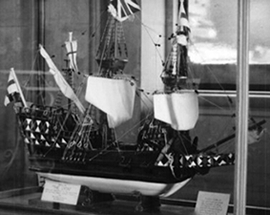 William, along with his older children, came to America before 1634, the exact year is not known, prior to his wife and younger children. According to The Great Migration Begins: Immigrants to New England, 1620-33, and information taken from the Winthrop Papers, it is likely that he was on the Lyon (mouse over picture left) which sailed from Bristol on December 1, 1630 and arrived in New England the following February.
William, along with his older children, came to America before 1634, the exact year is not known, prior to his wife and younger children. According to The Great Migration Begins: Immigrants to New England, 1620-33, and information taken from the Winthrop Papers, it is likely that he was on the Lyon (mouse over picture left) which sailed from Bristol on December 1, 1630 and arrived in New England the following February.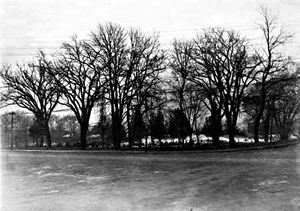 he is not to have the “œ40. . .Unto daughter (Hannah) Barnes, œ30, the same to remain unto her children. . . In case she again become a widow she to have wood from his lands during her widowhood. To four children of my daughter, Elizabeth House, deceased, various sums of money. To Adam Smith, son of daughter, Sarah, if he behave obediently to my wife after my decease, one mare, colt and œ20. . . To daughter, Sarah Smith, œ5.” He appointed his widow Elizabeth and son John executors. The will was witnessed by Matthew Bridge and Thomas Longhorne. The inventory was done by Hugh Mason and Thomas Hastings on December 16, 1662; “œ457-16-9.” It contains the following list of real estate: “25 acres of fallow land, 15 acres of broken land, 15 acres of meadow, 60 acres of meadow, &c., 16 acres of land in low of ye town right, 40 acres in great dividend, 160 acres in a farm. Total, 331 acres.” It is not known where William is buried but it could be in the Arlington Street Cemetery (mouse over picture right), which was the burying place of the early settlers.
he is not to have the “œ40. . .Unto daughter (Hannah) Barnes, œ30, the same to remain unto her children. . . In case she again become a widow she to have wood from his lands during her widowhood. To four children of my daughter, Elizabeth House, deceased, various sums of money. To Adam Smith, son of daughter, Sarah, if he behave obediently to my wife after my decease, one mare, colt and œ20. . . To daughter, Sarah Smith, œ5.” He appointed his widow Elizabeth and son John executors. The will was witnessed by Matthew Bridge and Thomas Longhorne. The inventory was done by Hugh Mason and Thomas Hastings on December 16, 1662; “œ457-16-9.” It contains the following list of real estate: “25 acres of fallow land, 15 acres of broken land, 15 acres of meadow, 60 acres of meadow, &c., 16 acres of land in low of ye town right, 40 acres in great dividend, 160 acres in a farm. Total, 331 acres.” It is not known where William is buried but it could be in the Arlington Street Cemetery (mouse over picture right), which was the burying place of the early settlers. Elizabeth Paine was baptized on and probably born just prior to September 11, 1586 in
Elizabeth Paine was baptized on and probably born just prior to September 11, 1586 in 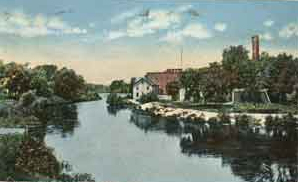 enclosing that passengers of the 30 May 1634 Francis and 30 May 1634 Elizabeth did not take the oaths.” They must have not been released as on January 21, 1635 they both brought back to England a list of all the passengers that went in their ships to New England in April 1634 with certificates of their having taken the Oaths of Supremacy and Allegiance, before they left England. Elizabeth was listed as taking the oath on November 12, 1633, at Ipswich.
enclosing that passengers of the 30 May 1634 Francis and 30 May 1634 Elizabeth did not take the oaths.” They must have not been released as on January 21, 1635 they both brought back to England a list of all the passengers that went in their ships to New England in April 1634 with certificates of their having taken the Oaths of Supremacy and Allegiance, before they left England. Elizabeth was listed as taking the oath on November 12, 1633, at Ipswich.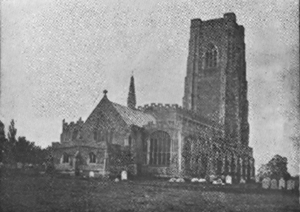 Thomas Hammond was probably born about 1545 in
Thomas Hammond was probably born about 1545 in 
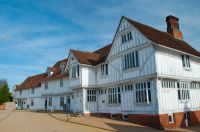 30, 1590, in Lavenham, and held possession of the estate left by Thomas until 1647 or after. That is the year that her son William wrote a letter of attorney to obtain possession of the estate from his mother, for his son Thomas. When the actual transition took place is not known. This suggests she lived until at least 1647, which would make her almost 100 years old. It may be that she had died and William was getting the estate back from her second husband’s family. This letter is only mentioned in one book, Genealogical and Family History of the State of New Hampshire: A Record of the Achievements of Her People in the Making of a Commonwealth and the Founding of a Nation, Volume 2, which was compiled by Ezra S. Stearns. It states about William: “He had given lands to his son Thomas prior to his death in 1655, and on December 12, 1647, he had given Thomas a letter of attorney to obtain possession of lands in Lavenham, England, which were then possessed by his (William's) mother, Mrs. Rose Stewart.” Without reading the content of the letter, it is impossible to say what exactly transpired. Rose Trippe Hammond Stuard died and was probably buried in the Lavenham Churchyard.
30, 1590, in Lavenham, and held possession of the estate left by Thomas until 1647 or after. That is the year that her son William wrote a letter of attorney to obtain possession of the estate from his mother, for his son Thomas. When the actual transition took place is not known. This suggests she lived until at least 1647, which would make her almost 100 years old. It may be that she had died and William was getting the estate back from her second husband’s family. This letter is only mentioned in one book, Genealogical and Family History of the State of New Hampshire: A Record of the Achievements of Her People in the Making of a Commonwealth and the Founding of a Nation, Volume 2, which was compiled by Ezra S. Stearns. It states about William: “He had given lands to his son Thomas prior to his death in 1655, and on December 12, 1647, he had given Thomas a letter of attorney to obtain possession of lands in Lavenham, England, which were then possessed by his (William's) mother, Mrs. Rose Stewart.” Without reading the content of the letter, it is impossible to say what exactly transpired. Rose Trippe Hammond Stuard died and was probably buried in the Lavenham Churchyard.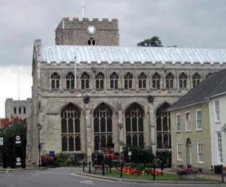 William Paine was born in
William Paine was born in 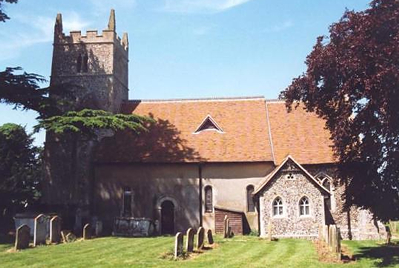 and intelligent citizens, who took most important parts in the of the early colonists of New England.” In the Visitation of Suffolke, daughter Anne was the only child still living with her parents in February of 1606. Most of the others should have been listed, but are not. It is generally agreed that those who went to America, where left off or removed from the published Visitation listings. A.W. Paine writes: “The fact that no children (except Anne,) are given to him in the Visitation, is conformable to the practice of the Heralds, who uniformly overlooked and ignored 'all who had deserted their country’." Thus Ann probably was the only one who stayed in England.
and intelligent citizens, who took most important parts in the of the early colonists of New England.” In the Visitation of Suffolke, daughter Anne was the only child still living with her parents in February of 1606. Most of the others should have been listed, but are not. It is generally agreed that those who went to America, where left off or removed from the published Visitation listings. A.W. Paine writes: “The fact that no children (except Anne,) are given to him in the Visitation, is conformable to the practice of the Heralds, who uniformly overlooked and ignored 'all who had deserted their country’." Thus Ann probably was the only one who stayed in England.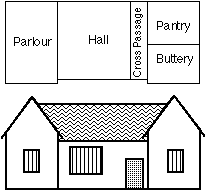 He was a clothier and as reported by Frederick Stam Hammond in volume one of his book History and Genealogies of the Hammond Families in America, which reads: “He undoubtedly settled there in connection with the cloth industry, of which Lavenham was at that time the center. . . King Edward III. impressed with the fact that England was sending her wool to Flanders to be made into cloth, induced the Flemings to come to England and settle and thus encouraged the manufacture of cloth at home. Lavenham was one of the towns in which they first settled and it became the center of the cloth trade.”
He was a clothier and as reported by Frederick Stam Hammond in volume one of his book History and Genealogies of the Hammond Families in America, which reads: “He undoubtedly settled there in connection with the cloth industry, of which Lavenham was at that time the center. . . King Edward III. impressed with the fact that England was sending her wool to Flanders to be made into cloth, induced the Flemings to come to England and settle and thus encouraged the manufacture of cloth at home. Lavenham was one of the towns in which they first settled and it became the center of the cloth trade.” 
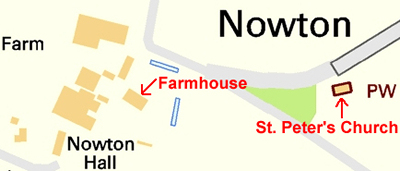 the law of inheritance. . . . Henry Paine died July 25, 1568, and was buried the next day in the Parish church of Nowton. He left a will, made a few days before his death, giving his estate, most of it, to charitable purposes. . . . The Manor of Nowton he settled on his brother Anthony. His will was proved Feb'y 2, 1569.”
the law of inheritance. . . . Henry Paine died July 25, 1568, and was buried the next day in the Parish church of Nowton. He left a will, made a few days before his death, giving his estate, most of it, to charitable purposes. . . . The Manor of Nowton he settled on his brother Anthony. His will was proved Feb'y 2, 1569.”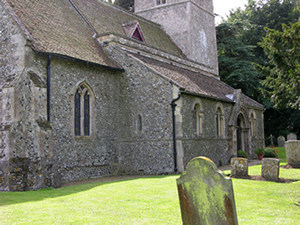 The will of Anthony Payne is dated February 16, 1606 and is described in the Visitation of Suffolke, made by William Harvey as follows: “Will of Anthony Payne, of Bury St. Edmund's, Gent. One of the witnesses to it, Anthony Payne, junr. Proved (Archd. Sudb.) 20 April, 1607, by his son Wm. Payne, Ex'or. He ordered his body to be buried in the chancel of Nowton church, near his late wife. Gave his house at St. Edmund's-bury to his son Wm. Payne, Gent., reserving power for the testator's daughter, Anne, wife of Wm. Weston, Gent., to reside there for 2 years after his decease, and after various legacies amongst which he gave to his son Wm. his nest of bolls with a cover, all gilt, having the arms of the Countess of Oxford upon them, also his silver salt with a cover, all gilt, with the picture of St. George set on the top; and gave his wife's wedding ring to Mary Payne, da. of Walter Payne, Gent. Names wife of his son William, and his the said William's daughter Anne. He gave the residue of his estate to his son Wm. Payne, whom he appointed sole Ex'or, appointing Wm. Cooke, of Bury St. Edmund's, Gent., Supervisor.” Anthony Payne died on March 3, 1606 and was buried in the Church of St. Peter Chancel area (pictured left) in
The will of Anthony Payne is dated February 16, 1606 and is described in the Visitation of Suffolke, made by William Harvey as follows: “Will of Anthony Payne, of Bury St. Edmund's, Gent. One of the witnesses to it, Anthony Payne, junr. Proved (Archd. Sudb.) 20 April, 1607, by his son Wm. Payne, Ex'or. He ordered his body to be buried in the chancel of Nowton church, near his late wife. Gave his house at St. Edmund's-bury to his son Wm. Payne, Gent., reserving power for the testator's daughter, Anne, wife of Wm. Weston, Gent., to reside there for 2 years after his decease, and after various legacies amongst which he gave to his son Wm. his nest of bolls with a cover, all gilt, having the arms of the Countess of Oxford upon them, also his silver salt with a cover, all gilt, with the picture of St. George set on the top; and gave his wife's wedding ring to Mary Payne, da. of Walter Payne, Gent. Names wife of his son William, and his the said William's daughter Anne. He gave the residue of his estate to his son Wm. Payne, whom he appointed sole Ex'or, appointing Wm. Cooke, of Bury St. Edmund's, Gent., Supervisor.” Anthony Payne died on March 3, 1606 and was buried in the Church of St. Peter Chancel area (pictured left) in 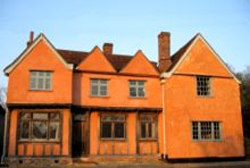 Protestant radicalism that was occurring at the time. Unfortunately nothing else is known about him. Martha married Anthony Payne sometime before 1557 and gave birth to at least four children all born in
Protestant radicalism that was occurring at the time. Unfortunately nothing else is known about him. Martha married Anthony Payne sometime before 1557 and gave birth to at least four children all born in 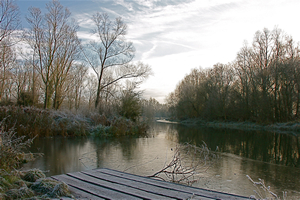 John Hamonde was born about 1475 in
John Hamonde was born about 1475 in 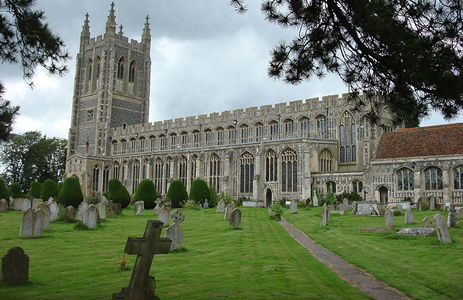 Johne/Johanna was born about 1475 in
Johne/Johanna was born about 1475 in  The following is a description of the Paine Coat of Arms written by A.W. Paine: “In order to a correct understanding of the several parts, it should be borne in mind that no part of the whole is black, save only the three ‘martlets sable’ - the ‘crest’ or wolf's head being azure or light blue, the border and belt red, the shield silver, the bezants or coins and mascles gold.
The following is a description of the Paine Coat of Arms written by A.W. Paine: “In order to a correct understanding of the several parts, it should be borne in mind that no part of the whole is black, save only the three ‘martlets sable’ - the ‘crest’ or wolf's head being azure or light blue, the border and belt red, the shield silver, the bezants or coins and mascles gold.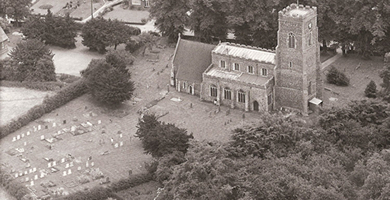 There is little information on John and Joan Hammond except that they both lived in
There is little information on John and Joan Hammond except that they both lived in 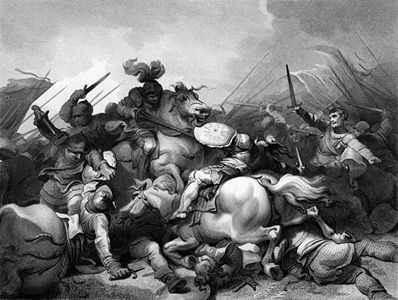 Edmund and Elizabeth both must have witnessed the horrors of the civil war and the Battle of Bosworth, which took place south of the town of Market Bosworth only seven years prior to the birth of ancestor William, their son. William Hervey’s The Visitation of Suffolk County was originally compiled in 1561, and extended two or three different times, within the following century. It was then supplemented by Gage in his History of Suffolk County. Both writers describe the Payne family as “resident in Leicestershire, upon the famous field of Bosworth where the last great battle of the Roses was fought, and the fate of the Houses of York and Lancaster decided by the death of Richard III., on Aug. 22, 1485.” (Mouse over image on left.)
Edmund and Elizabeth both must have witnessed the horrors of the civil war and the Battle of Bosworth, which took place south of the town of Market Bosworth only seven years prior to the birth of ancestor William, their son. William Hervey’s The Visitation of Suffolk County was originally compiled in 1561, and extended two or three different times, within the following century. It was then supplemented by Gage in his History of Suffolk County. Both writers describe the Payne family as “resident in Leicestershire, upon the famous field of Bosworth where the last great battle of the Roses was fought, and the fate of the Houses of York and Lancaster decided by the death of Richard III., on Aug. 22, 1485.” (Mouse over image on left.) 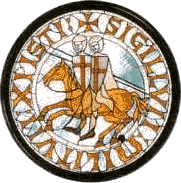 A.W. Paine believed that the first Payne ancestor in England was a second poor son named Hugh de Payen, one of William the Conqueror’s friends and commissioners who in 1086 took part in the gathering of information and writing of The Domesday report. “At the termination of the Crusade now spoken of, the celebrated Hugh de Payen remained
A.W. Paine believed that the first Payne ancestor in England was a second poor son named Hugh de Payen, one of William the Conqueror’s friends and commissioners who in 1086 took part in the gathering of information and writing of The Domesday report. “At the termination of the Crusade now spoken of, the celebrated Hugh de Payen remained 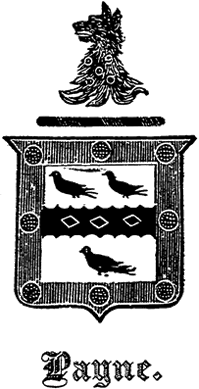 behind for the purpose of more surely securing its grand results. . . . In company with Godfrey de St. Orner, he instituted an order known as the 'Templars of the Cross,' the sole object of which was to further the great objects of the Crusaders' mission by protecting the Holy Places and rendering safe the journey of all pilgrims to the Holy Shrine. The original organization embraced only seven others besides themselves. . . . Who Hugh de Payen was, genealogically, or to what line he belonged, of the numerous families now existing, is a matter of much interest. That he was a Norman is very clear, for at that early day the name had not gone beyond the field of its orgin, for only a single generation, or two, had then passed since surnames had been first adopted. His name too, indicates that he was the son of a father who bore the same name, and who lived necessarily during the war and reign of the Conqueror. He was too, as a Norman, in the Crusade, one of the soldiers or followers of Robert the Duke. . . . From the readings of Domesday we have seen that Pagen, or Payen, was one of William the Conqueror's chief barons, on whom he especially bestowed his favors. . . The conclusion can hardly be resisted that the great Crusader was the son of him on whom King William so abundantly showered his favors, and that it was this favor with King William which opened the palace doors of King Baldwin at Jerusalem, and gave to the poor son a home and the prestige of his influence and his power. . .”
behind for the purpose of more surely securing its grand results. . . . In company with Godfrey de St. Orner, he instituted an order known as the 'Templars of the Cross,' the sole object of which was to further the great objects of the Crusaders' mission by protecting the Holy Places and rendering safe the journey of all pilgrims to the Holy Shrine. The original organization embraced only seven others besides themselves. . . . Who Hugh de Payen was, genealogically, or to what line he belonged, of the numerous families now existing, is a matter of much interest. That he was a Norman is very clear, for at that early day the name had not gone beyond the field of its orgin, for only a single generation, or two, had then passed since surnames had been first adopted. His name too, indicates that he was the son of a father who bore the same name, and who lived necessarily during the war and reign of the Conqueror. He was too, as a Norman, in the Crusade, one of the soldiers or followers of Robert the Duke. . . . From the readings of Domesday we have seen that Pagen, or Payen, was one of William the Conqueror's chief barons, on whom he especially bestowed his favors. . . The conclusion can hardly be resisted that the great Crusader was the son of him on whom King William so abundantly showered his favors, and that it was this favor with King William which opened the palace doors of King Baldwin at Jerusalem, and gave to the poor son a home and the prestige of his influence and his power. . .”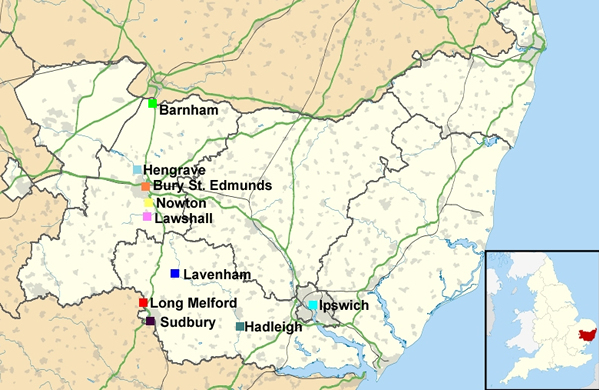 As you can see by the map, these ancestors lived along a north south line in the middle-western part of the county, known years ago as West Suffolk. (Today there is a major north-south route called A134.) Those that went to America went via Ipswich. Click on a town to read more about it.
As you can see by the map, these ancestors lived along a north south line in the middle-western part of the county, known years ago as West Suffolk. (Today there is a major north-south route called A134.) Those that went to America went via Ipswich. Click on a town to read more about it.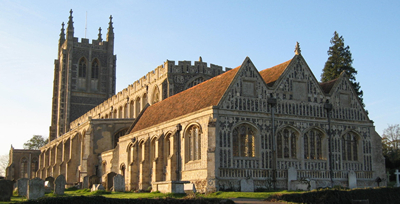 unit of area defined as 10,000 square meters of land. During the 15th century, when the first John Hammond came here, Melford was becoming rich. After the Peasants' Revolt most of the inhabitants were free men, renting their homes and lands, guilds were founded, and weaving cloth was as important as farming in building the village's wealth. The wealth of Long Melford at the time can be seen in its parish church, completed in 1484, the dimensions of which are more suited to a cathedral (pictured left). In the official inspector's returns for the year 1446, there were as many as 30 named weavers in Long Melford, who between them produced 264 finished "cloths". (Each cloth was over 26 meters long and 1.6 meters wide.) A lot of that wealth was put on show by building big houses down both sides of the main street (Hall Street). These houses had massive oak timbers in the frame, and almost all of them were built on the same general plan, known today as a Hall House (mouse over diagram in John Hammond's bio for more info). John Hammond left his house on Hall St to his son Thomas, who gave it to his brother William. In 1522 we know from the tax returns that there were seven men in Long Melford worth £50 or more in movable goods alone, (around £250,000 in today’s money). Three of them were “clothiers”, or cloth merchants. The much larger town of Sudbury had nine, of whom two were clothiers, while Lavenham, the boom town of the period, had twenty three, all but two of whom were in the woolen cloth business. At that time almost half the people whose trades were recorded in Long Melford were working in some aspect of the cloth trade, though there were five carpenters (in contrast to Lavenham, which had none!). From that high point the cloth trade in Suffolk began to decline. Overseas markets were lost through Henry VIII’s wars on the continent, while heavy taxation at home (to pay for those wars) reduced the local markets too. Meanwhile fashions changed in favor of lighter woolen fabrics than the traditional heavy “Kerseys” and broadcloths. The new lighter weaves were made further south, in the Essex towns like Colchester and Halstead, where refugees from the Continent settled (bringing their own weaving skills with them). The Suffolk towns survived by preparing yarn and other forms of outworking, but their leadership of the industry was gone for ever. (Information from
unit of area defined as 10,000 square meters of land. During the 15th century, when the first John Hammond came here, Melford was becoming rich. After the Peasants' Revolt most of the inhabitants were free men, renting their homes and lands, guilds were founded, and weaving cloth was as important as farming in building the village's wealth. The wealth of Long Melford at the time can be seen in its parish church, completed in 1484, the dimensions of which are more suited to a cathedral (pictured left). In the official inspector's returns for the year 1446, there were as many as 30 named weavers in Long Melford, who between them produced 264 finished "cloths". (Each cloth was over 26 meters long and 1.6 meters wide.) A lot of that wealth was put on show by building big houses down both sides of the main street (Hall Street). These houses had massive oak timbers in the frame, and almost all of them were built on the same general plan, known today as a Hall House (mouse over diagram in John Hammond's bio for more info). John Hammond left his house on Hall St to his son Thomas, who gave it to his brother William. In 1522 we know from the tax returns that there were seven men in Long Melford worth £50 or more in movable goods alone, (around £250,000 in today’s money). Three of them were “clothiers”, or cloth merchants. The much larger town of Sudbury had nine, of whom two were clothiers, while Lavenham, the boom town of the period, had twenty three, all but two of whom were in the woolen cloth business. At that time almost half the people whose trades were recorded in Long Melford were working in some aspect of the cloth trade, though there were five carpenters (in contrast to Lavenham, which had none!). From that high point the cloth trade in Suffolk began to decline. Overseas markets were lost through Henry VIII’s wars on the continent, while heavy taxation at home (to pay for those wars) reduced the local markets too. Meanwhile fashions changed in favor of lighter woolen fabrics than the traditional heavy “Kerseys” and broadcloths. The new lighter weaves were made further south, in the Essex towns like Colchester and Halstead, where refugees from the Continent settled (bringing their own weaving skills with them). The Suffolk towns survived by preparing yarn and other forms of outworking, but their leadership of the industry was gone for ever. (Information from 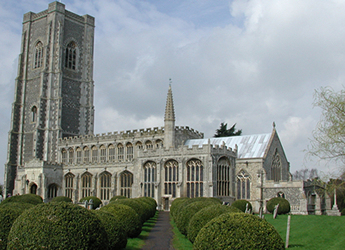 In the medieval period Lavenham was among the 20 wealthiest settlements in England. It prospered from the wool trade in the 15th and 16th century, with the town's blue broadcloth being an export of note. During the 16th century Lavenham industry was badly affected by Dutch refugees settled in Colchester who produced cloth that was cheaper and lighter than Lavenham's, and also more fashionable. The town's wealth can be seen in the lavishly constructed parish church of St Peter and St Paul (mouse over picture right) which stands on a hill top at the end of the main high street. The church is excessively large for the size of the village and with a tower standing 141 ft (43 m) high it lays claim to being the highest village church tower in Britain. The church is renowned for its Late-Gothic chantries and screens. The building is late perpendicular in its design and was probably not completed until 1530. The church contains five 15th century misericords (a small wooden shelf on the underside of a folding seat installed to provide a degree of comfort) featuring imagery such as composite creatures; one, half-woman, half beast playing a viol, and another, half-man with the hindquarters and tail of a beast, mimicking her by playing a pair of bellows with a crutch. The church is closely connected with the merchant families of the town, who paid for its construction and upkeep for many years.
In the medieval period Lavenham was among the 20 wealthiest settlements in England. It prospered from the wool trade in the 15th and 16th century, with the town's blue broadcloth being an export of note. During the 16th century Lavenham industry was badly affected by Dutch refugees settled in Colchester who produced cloth that was cheaper and lighter than Lavenham's, and also more fashionable. The town's wealth can be seen in the lavishly constructed parish church of St Peter and St Paul (mouse over picture right) which stands on a hill top at the end of the main high street. The church is excessively large for the size of the village and with a tower standing 141 ft (43 m) high it lays claim to being the highest village church tower in Britain. The church is renowned for its Late-Gothic chantries and screens. The building is late perpendicular in its design and was probably not completed until 1530. The church contains five 15th century misericords (a small wooden shelf on the underside of a folding seat installed to provide a degree of comfort) featuring imagery such as composite creatures; one, half-woman, half beast playing a viol, and another, half-man with the hindquarters and tail of a beast, mimicking her by playing a pair of bellows with a crutch. The church is closely connected with the merchant families of the town, who paid for its construction and upkeep for many years.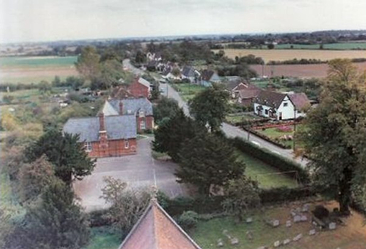 North of Lavenham is Lawshall, a village and civil parish located between Bury St Edmunds and Sudbury. The main avenue going through the middle of town is simply name The Street. Thanks to the Lawshall Archives Group web site for the photo to the right of The Street. It was taken from the All Saints' Church Tower, looking east, sometime prior to 1987. (Mouse over photo.)
North of Lavenham is Lawshall, a village and civil parish located between Bury St Edmunds and Sudbury. The main avenue going through the middle of town is simply name The Street. Thanks to the Lawshall Archives Group web site for the photo to the right of The Street. It was taken from the All Saints' Church Tower, looking east, sometime prior to 1987. (Mouse over photo.)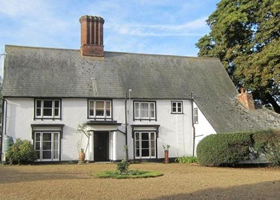 Nowton is a small village on the river Lark, located only two miles southeast to the center of Bury St Edmunds. Today it is on the southern edge, virtually a suburb of Bury St Edmunds. It is listed in the Domesday book as being one of the nineteen places in the Hundred of Thingoe and stands in flat, arable, good for farming, land. There are several buildings in Nowton that are on the British Listed Buildings list, including Anthony Payne's farm house and the Nowton Church. The cottages get older as they trail off into the countryside along the Hawstead road. The photo on left is an example of the houses that the ancestor's lived in. It is called Nowton Lodge and is a Grade II listed traditional Suffolk farmhouse and equestrian property with detached coach house, stables and paddocks in grounds of about 3.6 acres. It was built about 1508 and although improvements have been made to the front entrance, it retains many features typical of the period, including exposed beams, and an inglenook fireplace. It is in the same area of the rebuilt Nowton Hall, Nowton (St. Peter's) Church, and Nowton Park.
Nowton is a small village on the river Lark, located only two miles southeast to the center of Bury St Edmunds. Today it is on the southern edge, virtually a suburb of Bury St Edmunds. It is listed in the Domesday book as being one of the nineteen places in the Hundred of Thingoe and stands in flat, arable, good for farming, land. There are several buildings in Nowton that are on the British Listed Buildings list, including Anthony Payne's farm house and the Nowton Church. The cottages get older as they trail off into the countryside along the Hawstead road. The photo on left is an example of the houses that the ancestor's lived in. It is called Nowton Lodge and is a Grade II listed traditional Suffolk farmhouse and equestrian property with detached coach house, stables and paddocks in grounds of about 3.6 acres. It was built about 1508 and although improvements have been made to the front entrance, it retains many features typical of the period, including exposed beams, and an inglenook fireplace. It is in the same area of the rebuilt Nowton Hall, Nowton (St. Peter's) Church, and Nowton Park.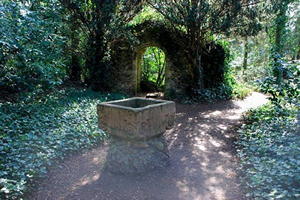 Much of where ancestors Anthony and Martha Payne and their son William lived has now become Nowton Park. The land that the park sits on, used to be part of Nowton Manor. It is now owned by the St. Edmundsbury Borough Council and managed for recreation, leisure and nature conservation. The park consists of almost two hundred acres of beautiful Suffolk countryside landscaped over one hundred years ago in typical Victorian style. The highly attractive landscape features a majestic lime avenue, many views and vistas, an arboretum and maze. A variety of circular walks are way-marked from half a mile up to two miles. Recreational facilities include an all-weather pitch and two football pitches, a children's play area, picnic area and park center with refreshments, information and toilets, and parking for two hundred vehicles. The photo to the right is taken within Nowton Park and seems to be a font and ivy covered archway along a walking path. This may be the remains of an old house or church or simply part of an outdoor garden.
Much of where ancestors Anthony and Martha Payne and their son William lived has now become Nowton Park. The land that the park sits on, used to be part of Nowton Manor. It is now owned by the St. Edmundsbury Borough Council and managed for recreation, leisure and nature conservation. The park consists of almost two hundred acres of beautiful Suffolk countryside landscaped over one hundred years ago in typical Victorian style. The highly attractive landscape features a majestic lime avenue, many views and vistas, an arboretum and maze. A variety of circular walks are way-marked from half a mile up to two miles. Recreational facilities include an all-weather pitch and two football pitches, a children's play area, picnic area and park center with refreshments, information and toilets, and parking for two hundred vehicles. The photo to the right is taken within Nowton Park and seems to be a font and ivy covered archway along a walking path. This may be the remains of an old house or church or simply part of an outdoor garden.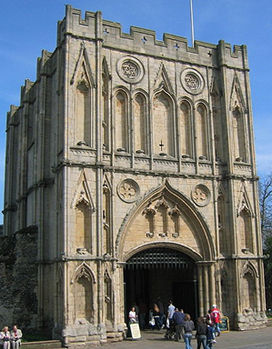 The name Bury is etymologically connected with borough , which has cognates in other Germanic languages such as the German bur meaning fortress, castle; Old Norse borg meaning wall, castle; and Gothic baurgs meaning city. They all derive from Proto-Germanic burgs meaning fortress. This in turn derives from the Proto-Indo-European root bhrgh meaning fortified elevation, with cognates including Welsh bera or stack and Sanskrit bhrant meaning high, elevated building. There is thus no justification for the folk etymology stating that the Cathedral Town was so called because St Edmund was buried there. The second section of the name refers to Edmund King of the East Angles, who was killed by the Vikings in the year 869. He became venerated as a saint and a martyr, and his shrine made Bury St Edmunds an important place of pilgrimage. The formal name of both the borough and the diocese is "St. Edmundsbury". Local residents often refer to Bury St Edmunds simply as Bury.
The name Bury is etymologically connected with borough , which has cognates in other Germanic languages such as the German bur meaning fortress, castle; Old Norse borg meaning wall, castle; and Gothic baurgs meaning city. They all derive from Proto-Germanic burgs meaning fortress. This in turn derives from the Proto-Indo-European root bhrgh meaning fortified elevation, with cognates including Welsh bera or stack and Sanskrit bhrant meaning high, elevated building. There is thus no justification for the folk etymology stating that the Cathedral Town was so called because St Edmund was buried there. The second section of the name refers to Edmund King of the East Angles, who was killed by the Vikings in the year 869. He became venerated as a saint and a martyr, and his shrine made Bury St Edmunds an important place of pilgrimage. The formal name of both the borough and the diocese is "St. Edmundsbury". Local residents often refer to Bury St Edmunds simply as Bury.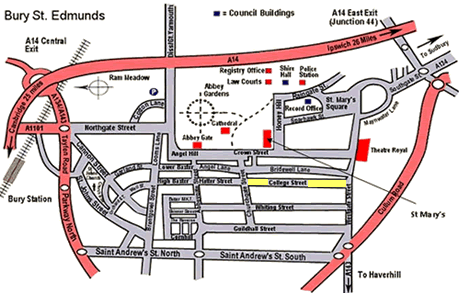 enriching itself. The riot destroyed the main gate and a new, fortified gate was built in its place. However in 1381 during the Great Uprising, the Abbey was sacked and looted again. This time, the Prior was executed; his severed head was placed on a pike in the Great Market.
enriching itself. The riot destroyed the main gate and a new, fortified gate was built in its place. However in 1381 during the Great Uprising, the Abbey was sacked and looted again. This time, the Prior was executed; his severed head was placed on a pike in the Great Market. 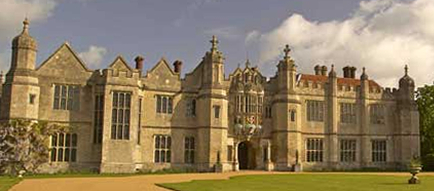 It is not clear whether the ancient manor was partly torn down by the Crown or by Kytson, but we know that Kytson rebuilt the entire building from 1525 to 1538 incorporating what was left of the ancient building as the north wing. In 1775 major
alterations were done and in 1897 to 1900 a new north wing was built on the site of
the demolished ancient wing. In 1838 Gage wrote about Kytson, "The mansion of Hengrave is a monument of his magnificence."
It is not clear whether the ancient manor was partly torn down by the Crown or by Kytson, but we know that Kytson rebuilt the entire building from 1525 to 1538 incorporating what was left of the ancient building as the north wing. In 1775 major
alterations were done and in 1897 to 1900 a new north wing was built on the site of
the demolished ancient wing. In 1838 Gage wrote about Kytson, "The mansion of Hengrave is a monument of his magnificence." 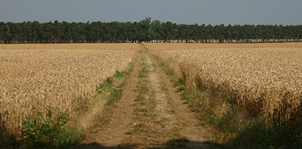 On the north end of our line is Barnham, a village and civil parish in the St Edmundsbury district. It is about 3 miles (4.8 km) south of Thetford in Norfolk County. According to Eilert Ekwall the meaning of the village name is "Beorn's homestead." The Domesday Book records the population of Barnham in 1086 to be 35 households, which was considered very large at the time. William and Agnes Payne were living there in 1607 just prior to their move to Nowton. The photo to the right is of West Calthorpe Heath, on the Byway, part of the Icknield Way, and is looking north-west across a field of wheat.
On the north end of our line is Barnham, a village and civil parish in the St Edmundsbury district. It is about 3 miles (4.8 km) south of Thetford in Norfolk County. According to Eilert Ekwall the meaning of the village name is "Beorn's homestead." The Domesday Book records the population of Barnham in 1086 to be 35 households, which was considered very large at the time. William and Agnes Payne were living there in 1607 just prior to their move to Nowton. The photo to the right is of West Calthorpe Heath, on the Byway, part of the Icknield Way, and is looking north-west across a field of wheat.